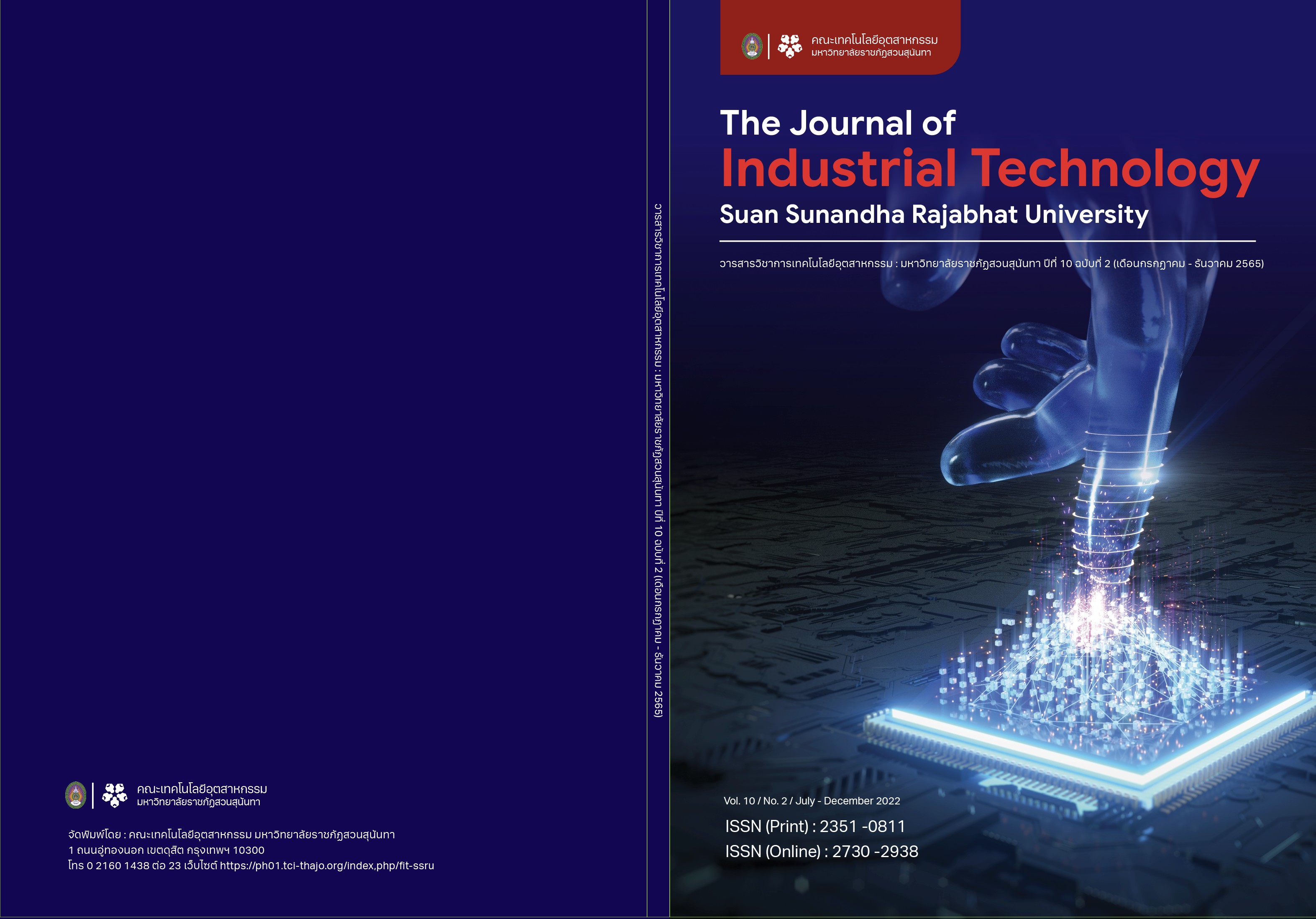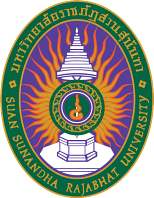ตัวแบบการพยากรณ์ปริมาณก๊าซคาร์บอนไดออกไซด์ ด้วยวิธีการวิเคราะห์การถดถอยและวิธีโครงข่ายประสาทเทียม
คำสำคัญ:
วิธีโครงข่ายประสาทเทียม, การวิเคราะห์การถดถอย, การพยากรณ์ปริมาณก๊าซคาร์บอนไดออกไซด์, ตัวแบบพยากรณ์, การปล่อยก๊าซคาร์บอนไดออกไซด์ภาคขนส่งบทคัดย่อ
งานวิจัยนี้มีวัตถุประสงค์เพื่อศึกษาวิธีการพยากรณ์ปริมาณการปล่อยก๊าซคาร์บอนไดออกไซต์ (CO2) ในประเทศไทย ซึ่งโดยส่วนใหญ่มีสาเหตุมาจากภาคอุตสาหกรรม ภาคการขนส่ง ภาคเศรษฐกิจ และภาคการผลิตไฟฟ้า เป็นต้น โดยการศึกษาในครั้งนี้ได้ประยุกต์ใช้วิธีการวิเคราะห์การถดถอย และวิธีโครงข่ายประสาทเทียมแบบหลายชั้นป้อนไปข้างหน้า ด้วยเทคนิคแบบแพร่กระจายย้อนกลับ โดยผู้วิจัยได้ทำการศึกษาพร้อมทั้งเก็บรวมรวมข้อมูลที่เป็นสาเหตุทำให้เกิดก๊าซ CO2 อาทิ ปริมาณการเพิ่มขึ้นของยานพาหนะ ปริมาณการใช้น้ำมัน จำนวนประชากร และผลิตภัณฑ์มวลรวมในประเทศ (GDP) เป็นต้น หลังจากนั้นทำการวิเคราะห์เพื่อออกแบบตัวแบบที่สามารถพยากรณ์ปริมาณก๊าซ CO2 ได้อย่างแม่นยำ โดยการประยุกต์ใช้ 2 วิธี คือ วิธีการวิเคราะห์การถดถอย กำหนดให้ค่าความเชื่อมั่นที่ 95 และวิธีโครงข่ายประสาทเทียมประมวลผลโดยใช้โปรแกรม MATLAB กำหนดให้สถาปัตยกรรมของโครงข่ายคือ 4-12-1 (input-hidden-output) ฟังก์ชันการถ่ายโอนคือ Positive Linear อัตราการเรียนรู้ที่ 0.02 และค่าวนซ้ำ 1000 รอบ จากผลการศึกษาพบว่าวิธีโครงข่ายประสาทเทียมสามารถพยากรณ์ปริมาณก๊าซ CO2 ได้อย่างมีประสิทธิภาพและแม่นยำกว่าวิธีการวิเคราะห์การถดถอยคิดเป็น 6 เท่า พิจารณาจากค่าเบี่ยงเบนสัมบูรณ์เฉลี่ย (Mean Absolute Deviation: MAD) ดังนั้นวิธีการโครงข่ายประสาทเทียมแบบหลายชั้นป้อนไปข้างหน้า ด้วยเทคนิคแบบแพร่กระจายย้อนกลับเป็นวิธีที่เหมาะสม สามารถพยากรณ์ปริมาณก๊าซ CO2 ได้อย่างมีประสิทธิภาพ
เอกสารอ้างอิง
C. Pratum, "Feasibility Study of Carbon Dioxide Recycling Using a Biological Wastewater Treatment System for Industrial Sources," Journal of Environmental Management, vol. 11, no. 2, pp. 106-133, 2015.
P. Bunprom and J. Kaewdam, "A study of Carbondaioxide Gas Emission from alcohol beverage industrial process," Suddhiparitad, vol. 25, no. 77 (September -December), pp. 7-18, 2011.
Energy Policy and Planning Office (EPPO), Ministry of Energy, " CO2 Emission by Energy Type and Sector.," Bangkok, 2559.
Energy Policy and Planning Office (EPPO), Ministry of Energy, " CO2 Emission by Energy Type and Sector.," Bangkok, 2559.
P. Wongwut, “CO2 Emission from Energy Consumption in Thailand” Thesis, Bachelor of Science, King Mongkut's Institute of Technology, 2536.
Climatogical Center (2022, March). [Online]. Available: http://www.climate. tmd.go.th/content/file/2104
Y. Panmanee, C. Jaiphet and A. Boonpoke, "Greenhouse gas emission from road transportation sector: A case study of transportation cooperative service," Naresuan Phayao Journal, vol. 6, no. 3, pp. 231-236, 2013.
T. Limanond, S. Uttra, C. Chermkhunthod and A. SriKaew, "Comparing the Performance of Automobile Ownership Model: By Multiple Linear Regression Analysis Method and Back-Propagation Learning of ANN Method," in The 3rd Atrans Symposium Student Chapter Session, Bangkok, 2010.
W. Yu, F. Zhao, H. Xu, M. Xu, W. Yang, K. Boonsiah, and S. Prabakaran, “Predictive control of CO2 emissions from a grate boiler based on fuel nature structures using intelligent neural network and Box-Behnken design,” in the 10th International Conference on Applied Energy, Hong Kong, China, 22-25 August, pp.364-369, 2018.
Statistics and research methodology for information technology. (2019, August 17) Regression Analysis. [Online]: Available:http://home.dsd.go.th/kamphaengkkam/km/inforinform/RESECARCH/000Regression.pdf
A. Sarasiri. (2019, August). An Artificial Neuron Network of Technique. [Online]. Available:https://sites.google.com/site/powerpow/phost-him/thekhnikhkarreiy nruphunthankthekhnikhkarreiynruphu
An integral element of the Ministry of Energy, the Energy Policy, and Planning Office (EPPO). (2019, August). Energy Statistics of Thailand. [Online]. Available: http://www.pagemakerth.com/eppostat2018/#p=9
ดาวน์โหลด
เผยแพร่แล้ว
รูปแบบการอ้างอิง
ฉบับ
ประเภทบทความ
สัญญาอนุญาต
ลิขสิทธิ์ (c) 2022 คณะเทคโนโลยีอุตสาหกรรม มหาวิทยาลัยราชภัฎสวนสุนันทา

อนุญาตภายใต้เงื่อนไข Creative Commons Attribution-NonCommercial-NoDerivatives 4.0 International License.
บทความที่ได้รับการตีพิมพ์เป็นลิขสิทธิ์ของคณะวิศวกรรมศาสตร์และเทคโนโลยีอุตสาหกรรม มหาวิทยาลัยราชภัฎสวนสุนันทา
ข้อความที่ปรากฏในบทความแต่ละเรื่องในวารสารวิชาการเล่มนี้เป็นความคิดเห็นส่วนตัวของผู้เขียนแต่ละท่านไม่เกี่ยวข้องกับมหาวิทยาลัยราชภัฎสวนสุนันทา และคณาจารย์ท่านอื่นๆในมหาวิทยาลัยฯ แต่อย่างใด ความรับผิดชอบองค์ประกอบทั้งหมดของบทความแต่ละเรื่องเป็นของผู้เขียนแต่ละท่าน หากมีความผิดพลาดใดๆ ผู้เขียนแต่ละท่านจะรับผิดชอบบทความของตนเองแต่ผู้เดียว








